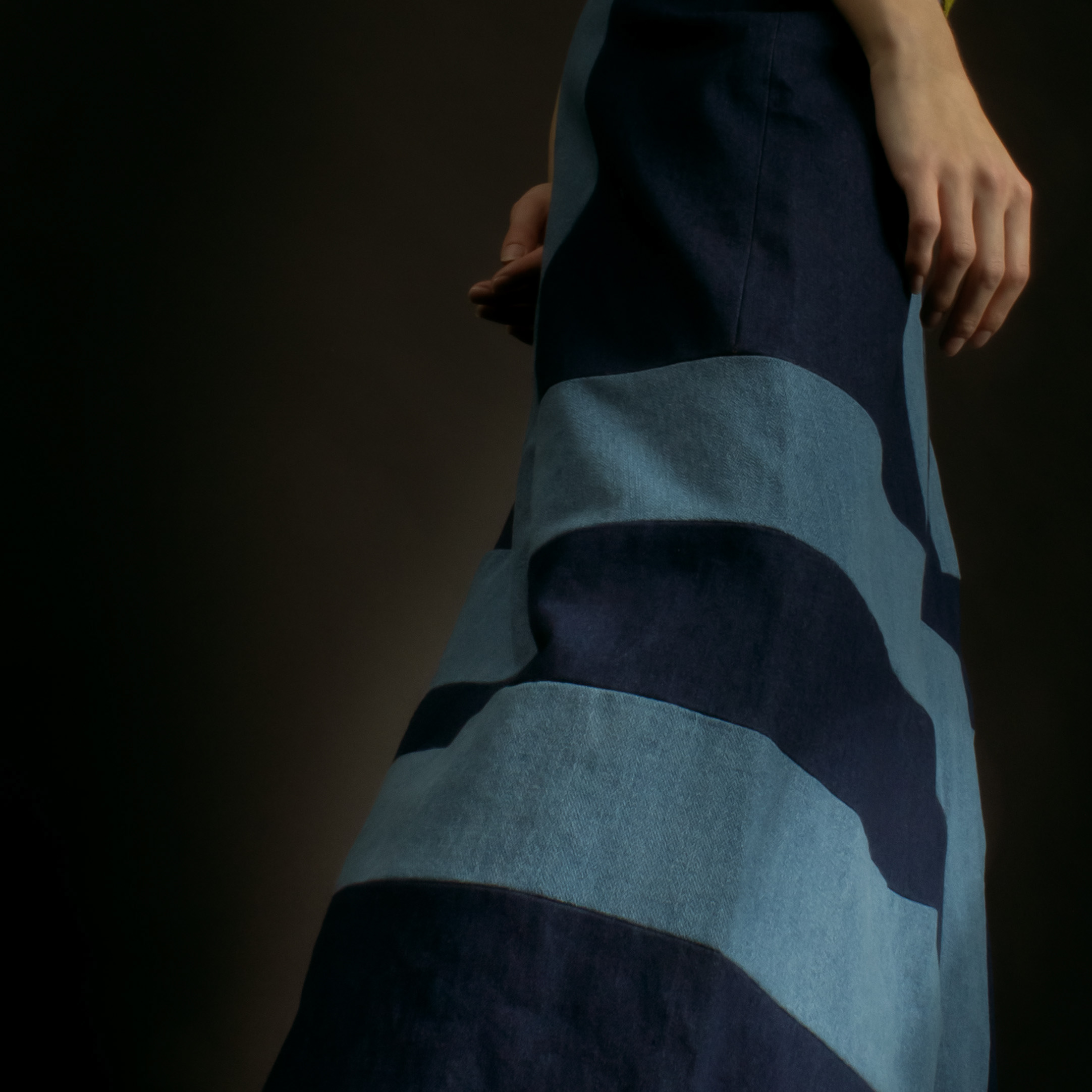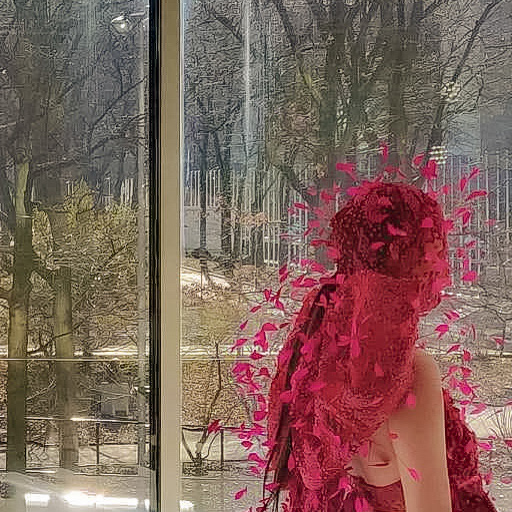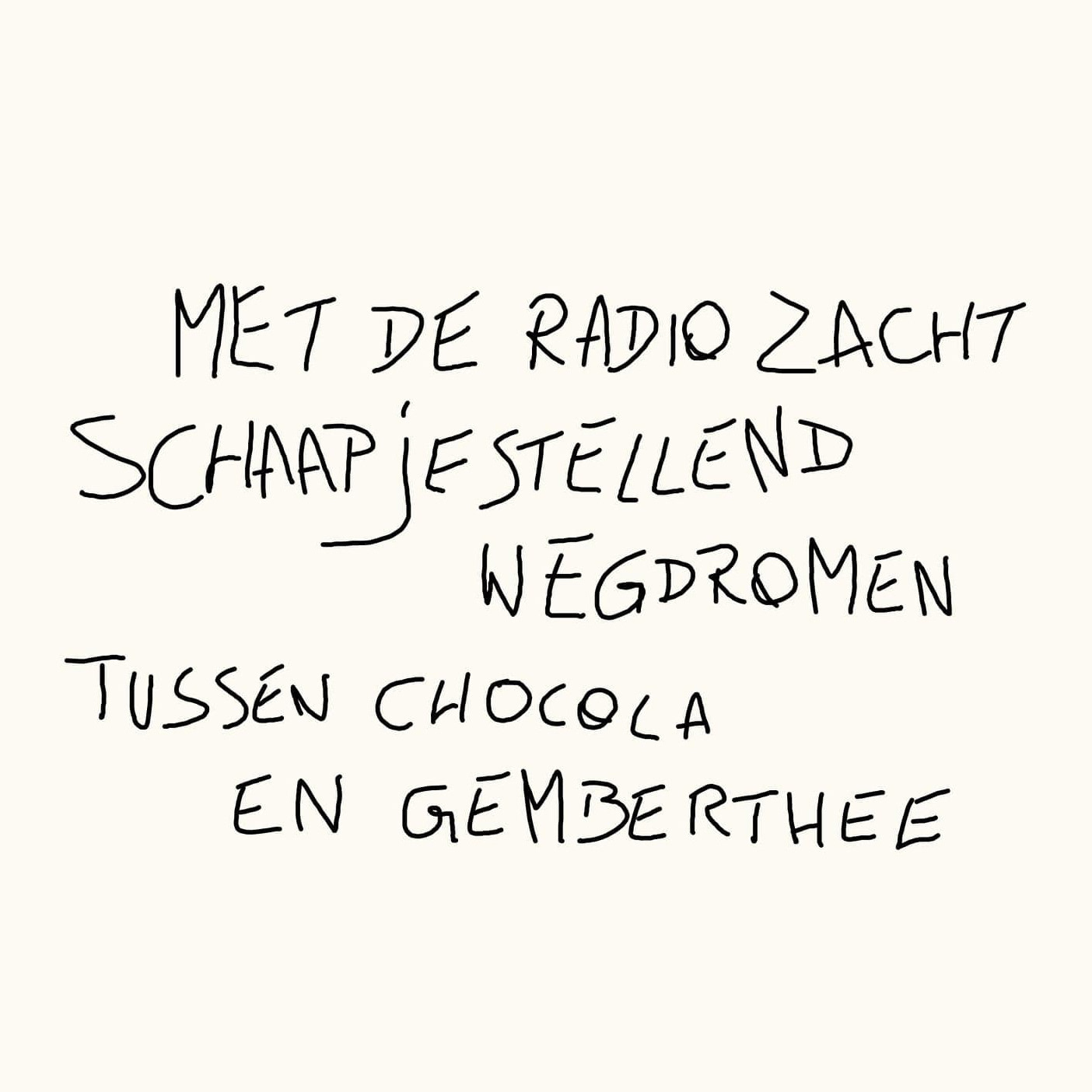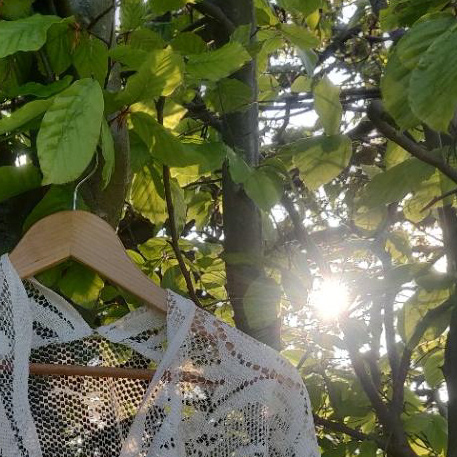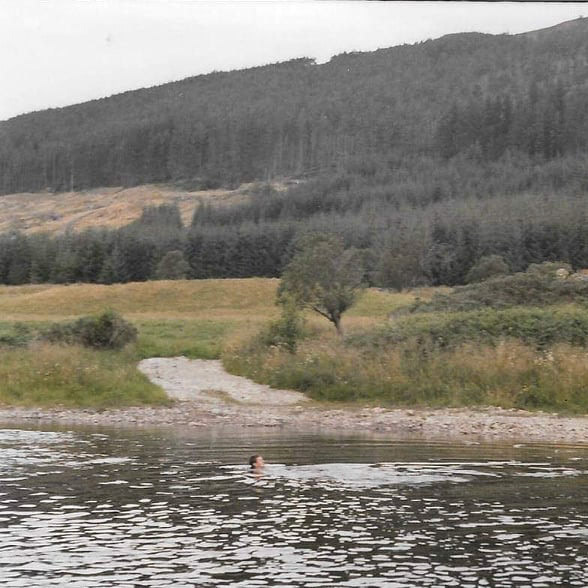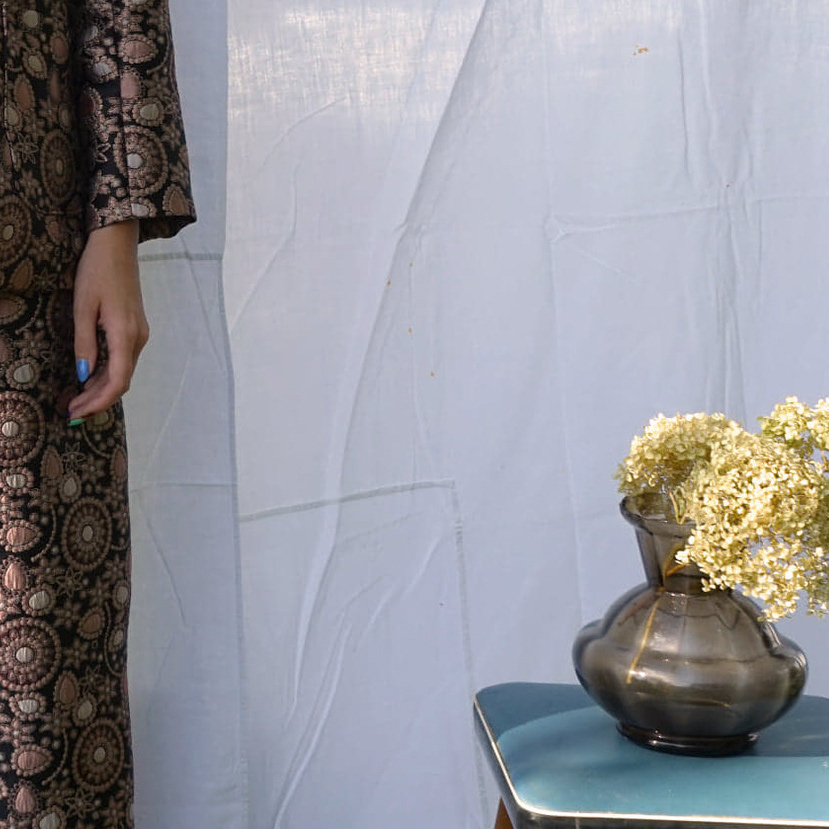In this project, I am looking for ways to make my design as sustainable as possible. The first criterion for this is to keep my dust loss below 5%. I will work with a piece of 2m10 by 1m45 from which I will make a full skirt and use the leftover fabric in a matching top. In addition, I also want to work with as many recycled materials as possible, both for the fabric and for the finishes.
In the first part of this project, I investigate how I can tackle these issues in concrete terms. My goals are divided into four studies: limiting fabric consumption, doing more with less, general zero-waste and personalizing fabric.
Then I work out a few mood boards that clarify the identity of my brand. The target group will also be determined in this part.
I then process my five designs into matching mood boards that create a better picture of the atmosphere of the different designs. The production process of the chosen design is further explained based on photo material. My result can be seen in a video and some photos. Finally, I also list my final thoughts about the past project.
I then process my five designs into matching mood boards that create a better picture of the atmosphere of the different designs. The production process of the chosen design is further explained based on photo material. My result can be seen in a video and some photos. Finally, I also list my final thoughts about the past project.
LIMIT FABRIC CONSUMPTION
In recent years, the clothing industry has become increasingly known for producing an enormous amount of waste. About 15% of the fabric is thrown away after the pattern pieces are cut out. This residual material is rarely recycled. One can try to arrange the pattern parts as optimal as possible, but the patterns for conventional clothing will always provide residual space. To combat this problem, zero-waste fashion has been created. Zero-waste patterns have little or no residual space, which means that the waste mountain remains small. Many designers also opt to even choose their materials in an ecologically responsible manner (Yen, n.d.).
Zero-waste pattern drawing, in the past
Zero-waste patterns are not a new trend. In 1919, Madeleine Vionnet designed the Jabot dress: a simple, elegant dress consisting of only two squares and two seams (Figure 1). Vionnet also often made use of patterns in bias for her later designs. In this way, she was able to make longer pattern pieces without seams for her long evening dresses (Rissanen, 2013).
Figure 1: Jabot - Madeleine Vionnet
Figure 2: Exhibition Yeohlee Teng at the Pheonix Art Museum
Zero-waste pattern drawing, now
Today we mainly see large volumes in zero-waste designs. Designers such as Timo Rissanen, Karin Vlug and Yeohlee Teng create thoughtful fabric plans in which every square centimetre is used. These plans often result in garments with large volumes and rather simple shapes. A large part of Teng's designs is made up of straight lines. The composition of rectangles and triangles of different sizes often gives a minimalist look (Figure 2).
Close-fitting garments are difficult to achieve with zero-waste pattern drawing as the centring of, for example, the waist creates curved lines on the pattern. However, the residual space that is created with this can be concealed in other pattern parts. Some designs by Holly McQuillan, a New Zealand designer, nevertheless bring out the natural shapes of the body, without using more material (figure 3). With her Make/Use project she shares these patterns so the customer can make the pieces themselves. In this way it prevents overproduction. Mcquillan does not often use many different pattern pieces, which gives the designs a minimalistic edge, but the use of curved lines makes the garment look less minimalist than is the case with Teng, for example. McQuillan's designs are often even built from one uniform part into which she cuts loose lines that serve as armholes or necklines (Make/Use, n.d.).
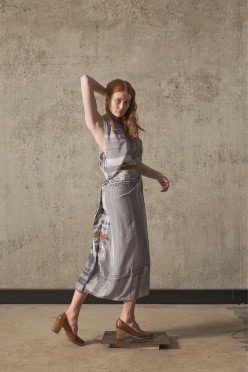
Figure 3a: Designed by Holly McQuillan

Figure 3b: Designed by Holly McQuillan

Figure 3c: Designed by Holly McQuillan
Conclusion
When a zero-waste garment is made from one of several large surfaces, it often has a very minimalist appearance. To create a rather maximalist design, curved lines and more different buildings and parts can be used. The difficulty is then mainly in making the puzzle for the dust plan to create as little waste as possible.
MORE WITH LESS
The details that are applied to a garment determine almost the entire atmosphere of that garment. It can make a simple skirt look very maximalist in the end. Jewels, pearls and embroidery have been attached to designs for centuries to convey the designer's style and message. But in what ways can you go from a simple, minimalist design to a maximalist result?
Alessandro Michele
Michele has been creative director at Gucci since 2015 and has since transformed the entire identity of the fashion house. From a formal point of view, the designs he makes are fairly simple, it is only with the finishes and accessories that the brand identity emerges. As can be seen in figure 4, the garments do not have complex shapes or volumes, but the choice of materials, the use of a lot of colours and the finish ensure that the clothing and accessories do not look so minimalistic after all.
Common finishes include pearls, embroidered flowers and animals, studs and faux fur trims. The main reason why these finishes work so well together is their high quality and refinement. A complex embroidery like the one on the green jacket (figure 4) is difficult to make by hand, but with the right dimensions, studs and pearls can be used to make your design more interesting (blue jacket, figure 4). In that case, it's especially important that everything is equally far from each other and is neatly attached so it does not look 'crafty'.
The difficulty here is in bringing out the childish playfulness, without the design appearing to have been made by a child. In the video below, Michele explains how he adds that playful element to his designs and why he thinks it is so important (figure 5).
Figure 4: Gucci Spring 2016
Figure 5: Make The Strange Beautiful: Backstage with Alessandro Michele for Gucci Men's Fall Winter 2020
Conclusion
To give a simple design with simple lines and volumes a maximalist character, a lot of attention must be paid to the finishes. The degree of difficulty has to be taken into account, for example, embroidery can look less professional if it is not applied precisely enough. Pearls and studs can give a luxurious edge to a design much more easily.
GENERAL ZERO-WASTE
I attach great importance to the ecological responsibility of the clothes I buy, so my third goal is to make my design as ecological as possible. For the fabric, I will probably work with a second-hand tablecloth, curtain or another used piece of fabric so I don't have to buy anything new. However, this is a challenge as I will never find exactly what I am looking for, but I would like to take on that challenge. In order to also keep my finishes ecologically responsible, I will look for techniques to make pearls or sequins from recycled materials. I base this on the work of Rachel Ellenbogen, a fashion student at Parsons School of Design.
"For my piece I wanted to focus on what I could make with recycled materials. I used recycled polyester chiffon as both a base for the beading and for the pleated details. For the beads I used plastic bottles and beads from second hand jewelry. I made the plastic bottles into beads by cutting them into leaf shapes, coloring them with an alcohol marker and then burning them to set the color and melt the edges. I used tambour beading for the majority of it, and a needle and thread for the bottles.
Something that has been on my mind a lot lately is how I react with the world around me. Particularly, what space I take up and what resources I use and throw away. I decided to take a more personal approach to nature and use the colors that I found around me in my everyday life. My goal was to create a painting with the beads and plastic bottles to hopefully inspire others to think about what we use and throw away and the resources, we as humans, use in the world.
I want to use the beauty in embroidery to bring about change and inspire people. I’m hoping that the detail in my work can pull people in and it can help them think critically about how what we use can affect the planet we live on."
- Rachel Ellenbogen on her design that won her second prize in the Student Fashion Category at the Hand & Lock Prizes in 2020
Details of Rachel's design at the Prize shoot.
From left to right:
1: Small circle-shaped sequins from plastic bottles
2 & 3: Small leaf-shaped sequins from plastic bottles
4: Large leaf-shaped sequin from plastic bottles
PERSONALIZING FABRIC
Since I choose a second-hand fabric to make my design, there is little chance that it will fully match what I want, so I searched for different dyeing techniques to personalize my fabric. To achieve the overall zero-waste in my design, including the dyeing too, I choose natural products to colour my fabric.
Upper left: White cotton dyed with beetroot and red cabbage
Upper right: Unbleached cotton dyed with turmeric
Bottom left: White cotton dyed with frozen raspberries
Bottom right: White cotton dyed with the pit and the skin of avocados
TARGET GROUP
This collection is designed for men and women who like to colour outside the lines, lead a sustainable lifestyle and attach great importance to self-expression and freedom, both mentally and physically.
STYLE & IDENTITY
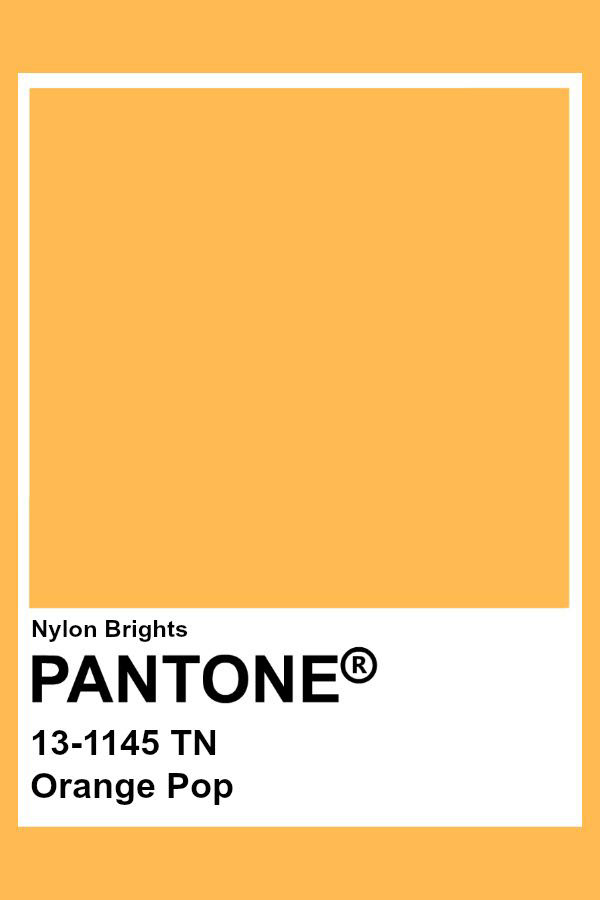
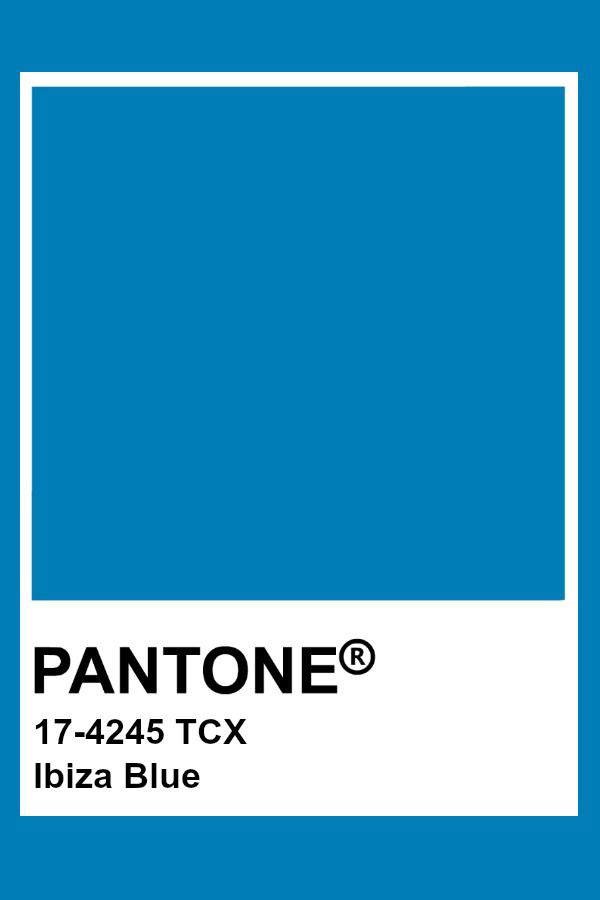
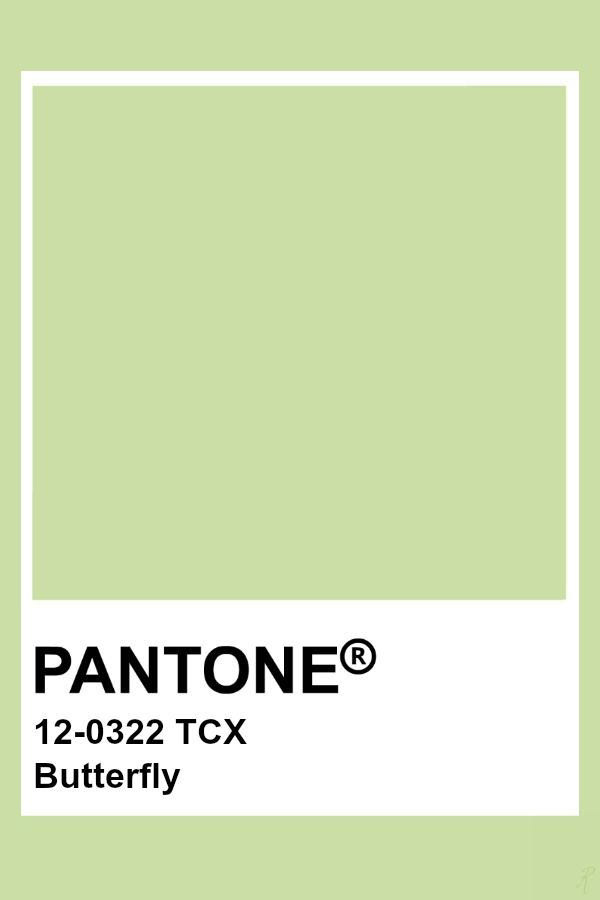
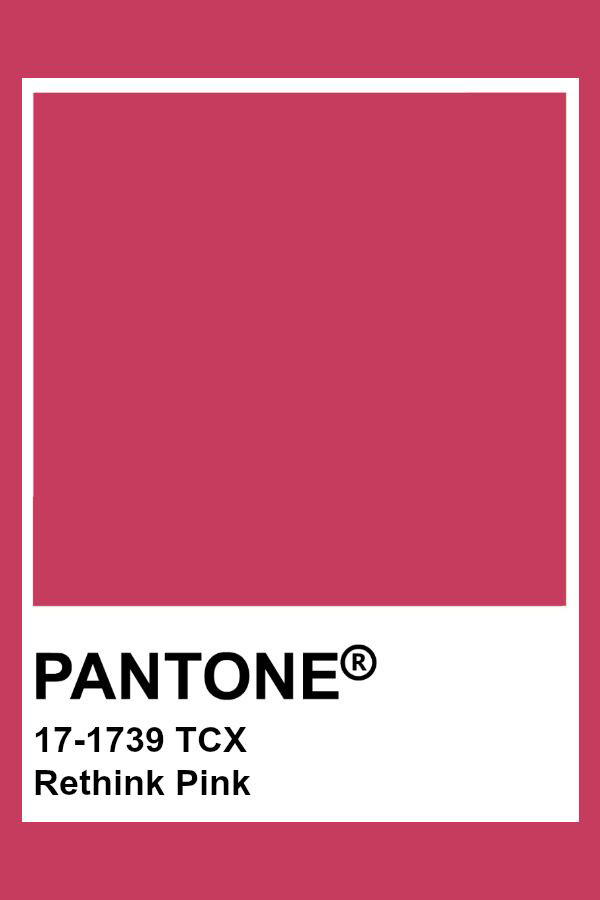


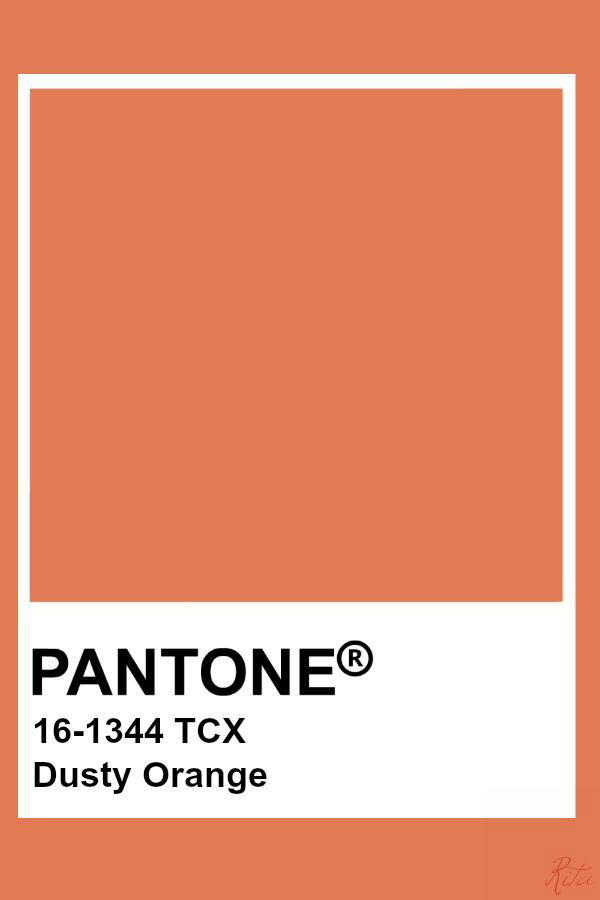
DESIGN N°1
- CHOSEN DESIGN -
DESIGN N°2
DESIGN N°3
DESIGN N° 4
DESIGN N°5
ELABORATION DESIGN N°1
- PREPARATION -
Fabric plan at true size
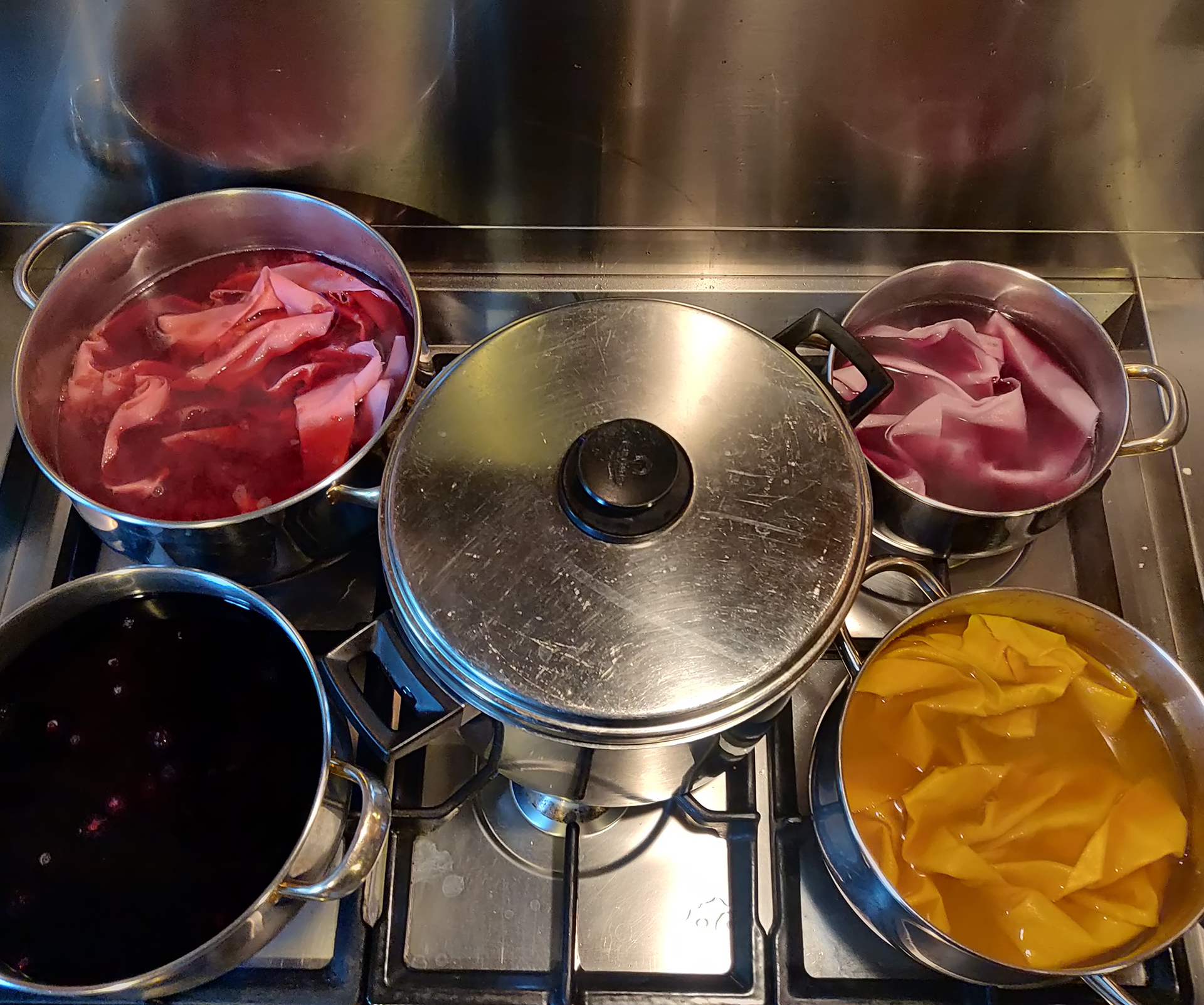
Dyeing with natural products
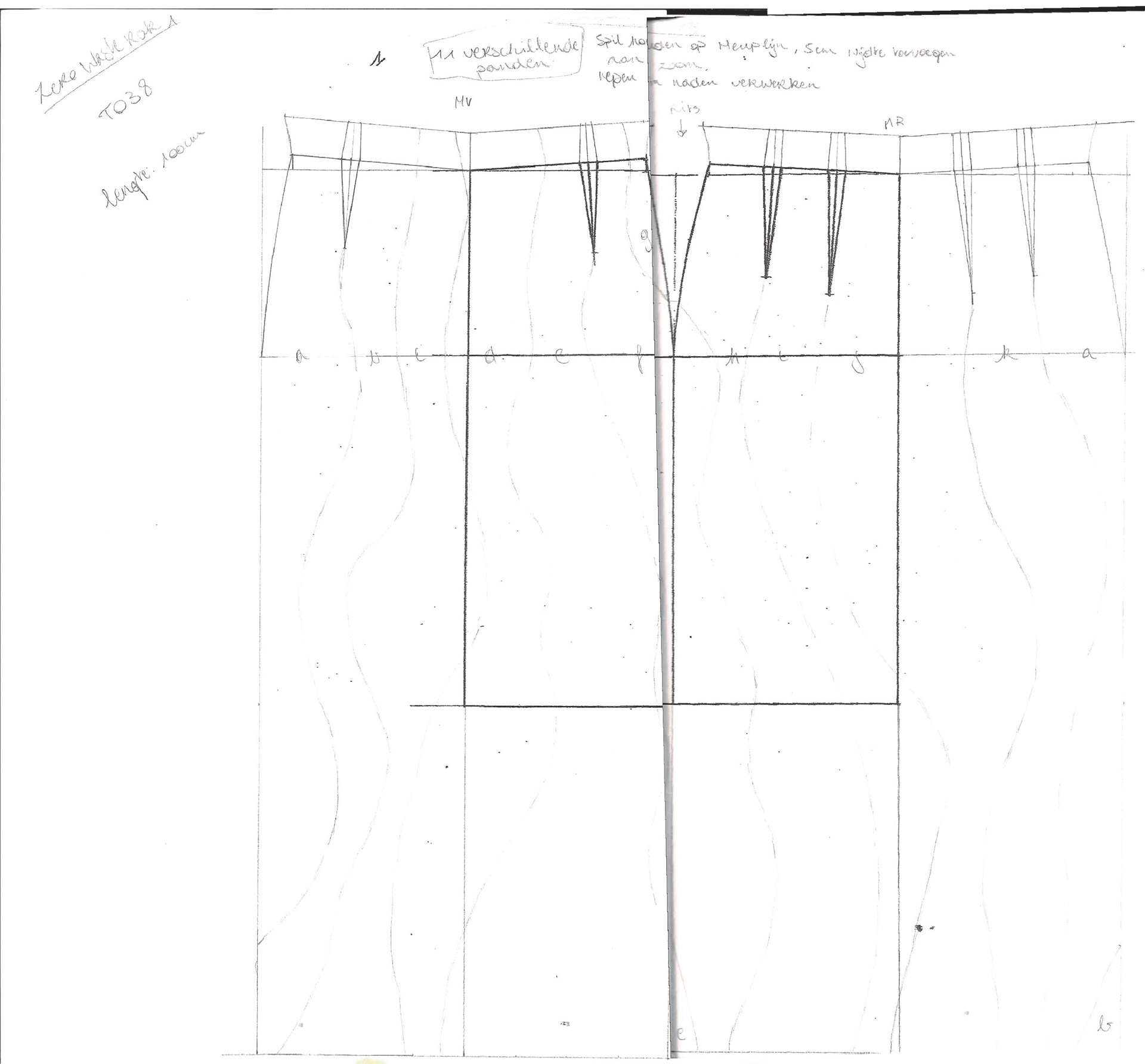
Model drawing at 1/4 scale

Pattern pieces divided among the different natural products

Dyeing with turmeric
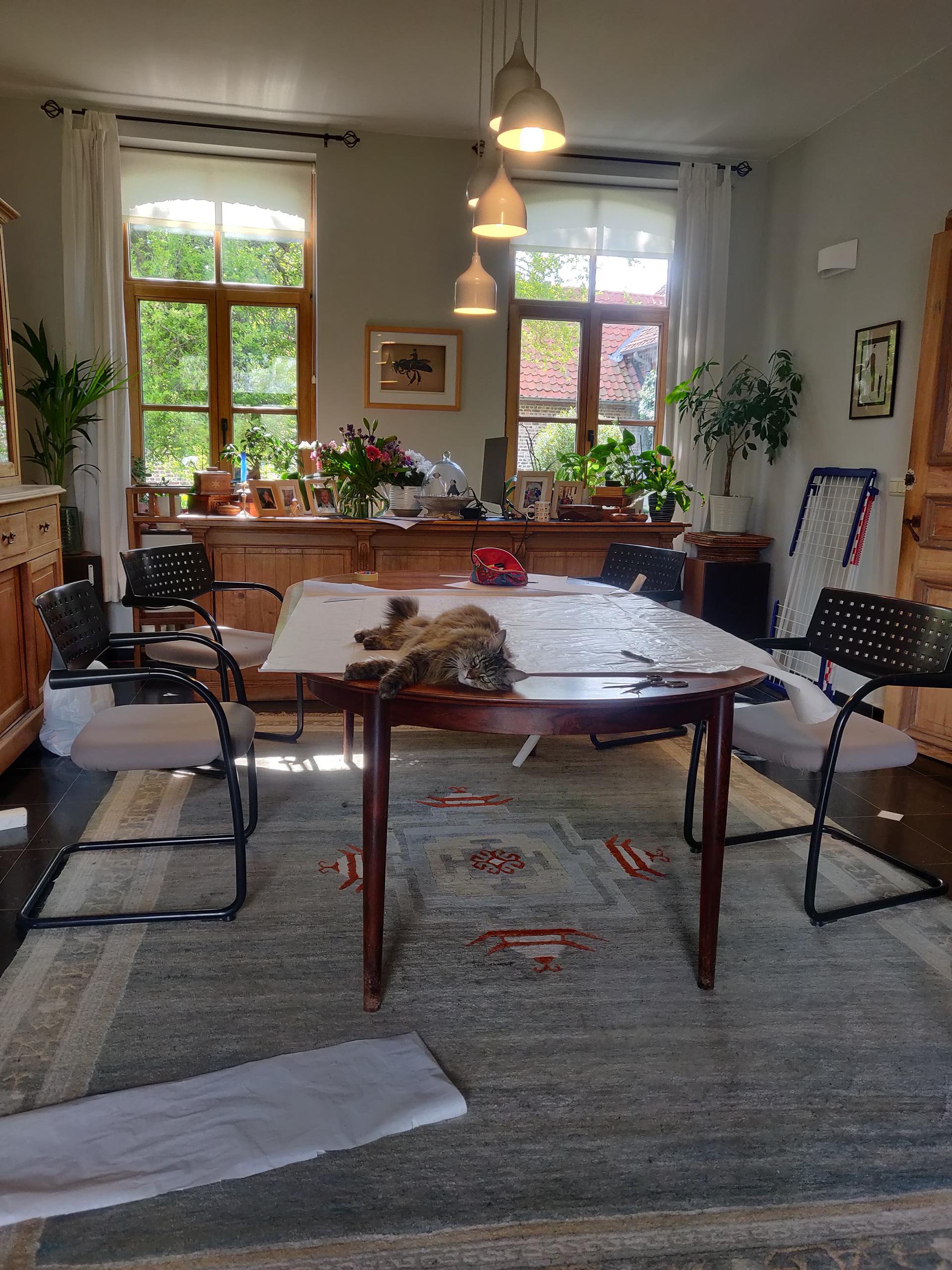
While making my pattern pieces
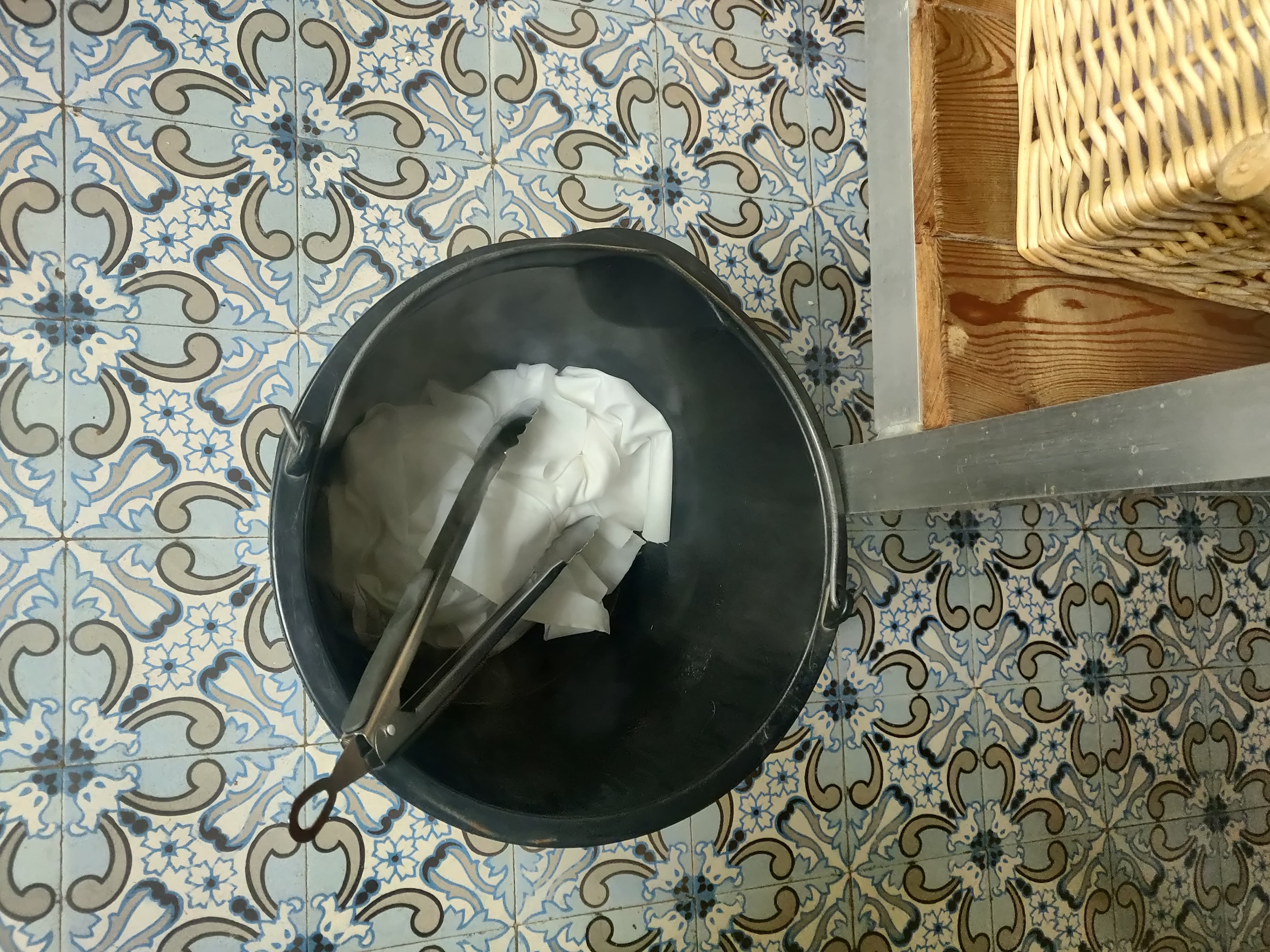
Pattern pieces after treatment with vinegar
Leftover fabric: <5%
Explanation of residual spaces on the fabric plan:
- Wavy gaps between long wavy pattern pieces: pattern pieces for matching top.
- Rectangular residual space next to small pattern piece for zipper (bottom right of photo above): labels and care labels
- RESULTS PROTOTYPE -
Front prototype
Back prototype
- RESULTS SAMPLE -
Audio: Strawberry Fields Forever - The Beatles

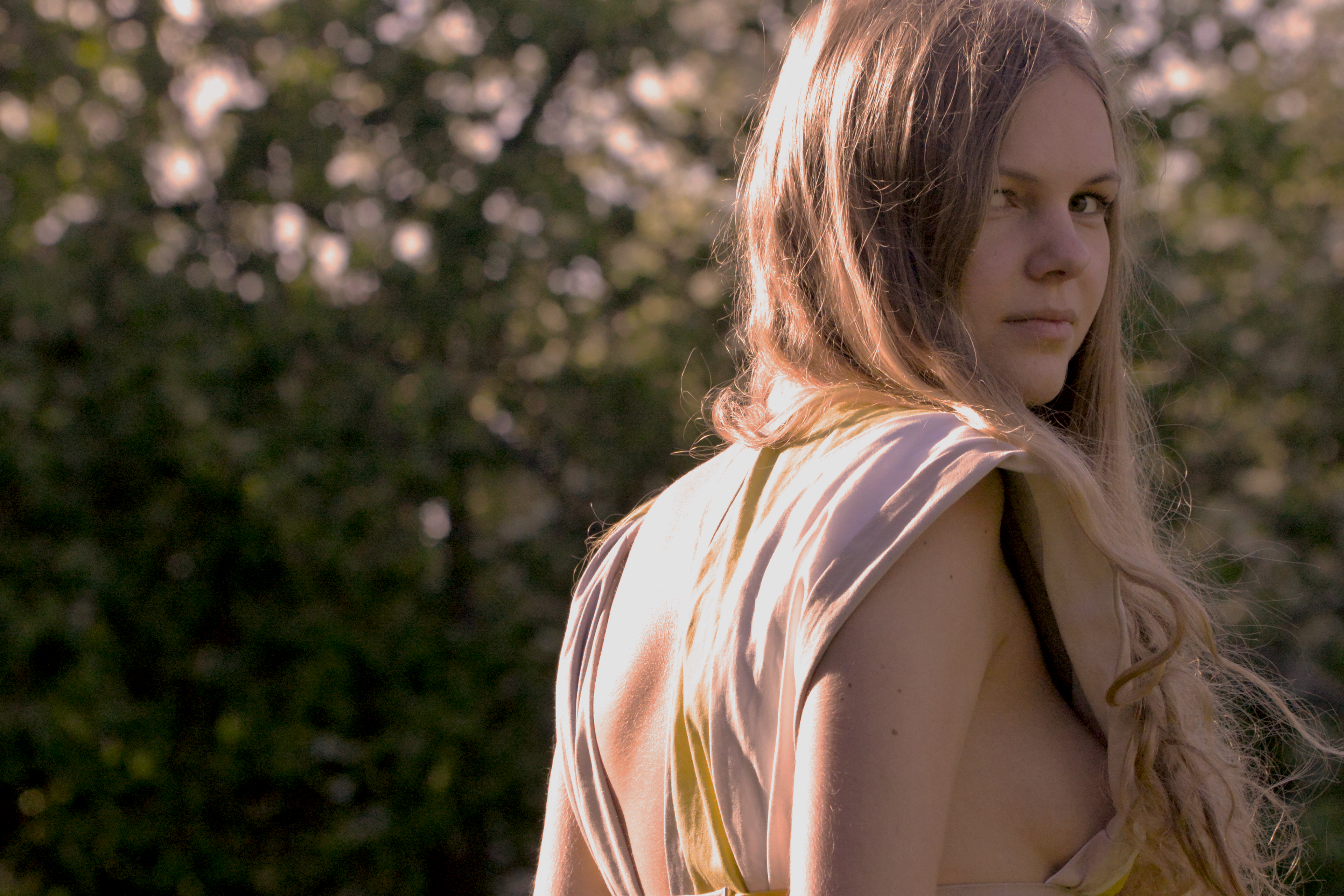

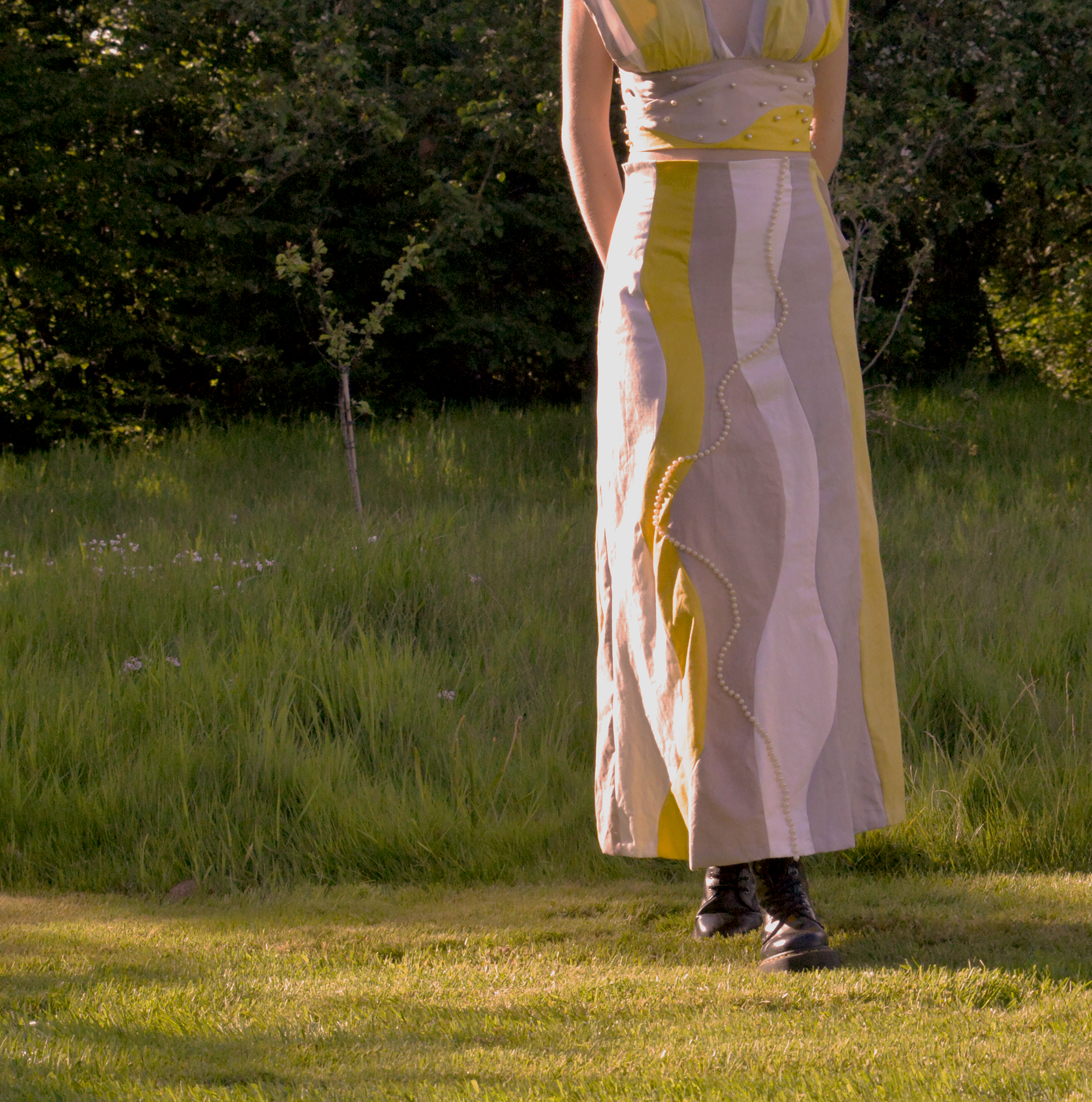
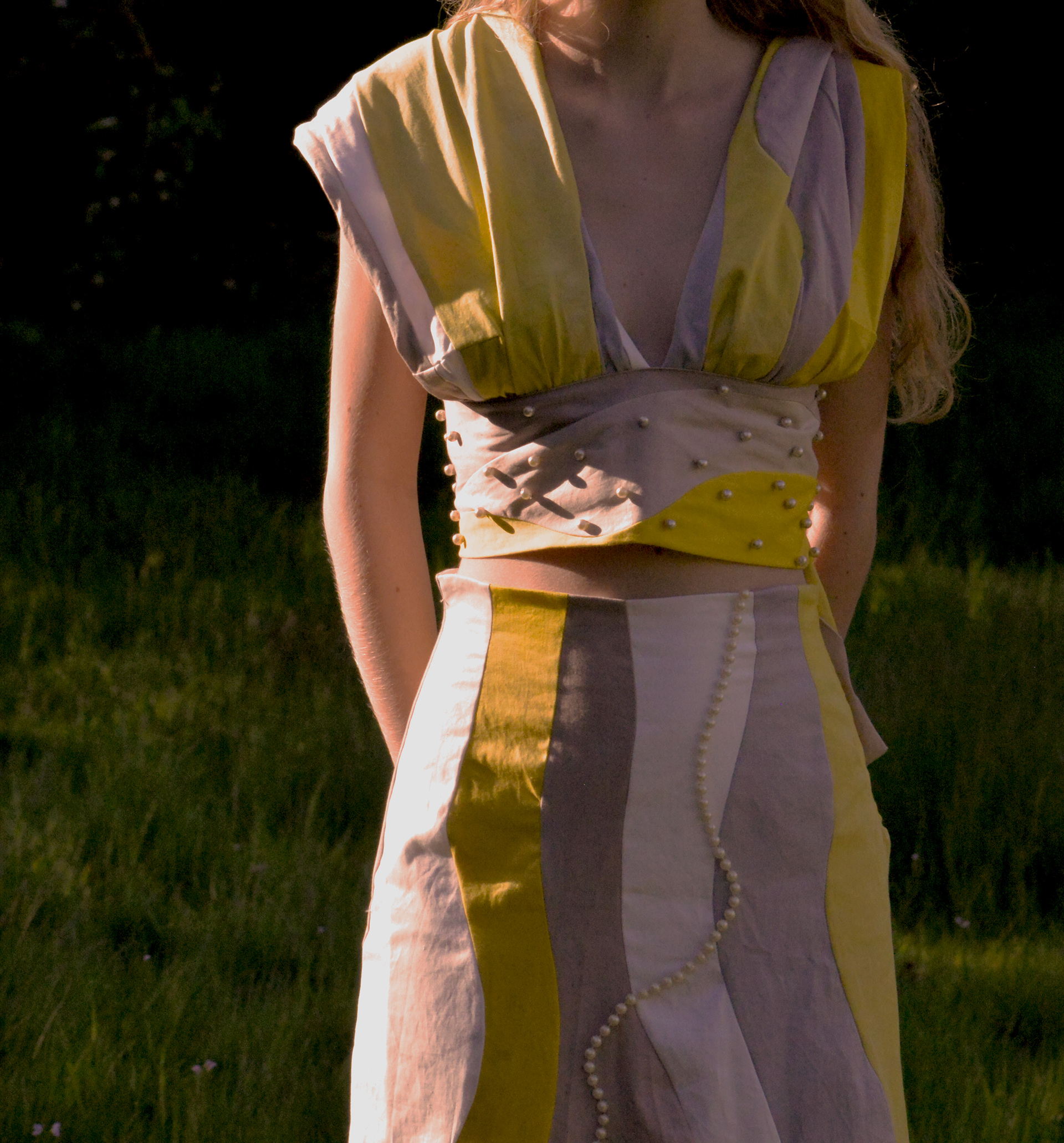

FABRIC
I found the white cotton fabric in the attic, so I didn't have to buy new fabric. The fabric had a surface of 2m10 by 1m45, which allowed me to create enough residual space for a matching top. Since I already had a white base, colouring was also much easier and the colours came out better than if I had worked with regular unbleached cotton.
PEARLS
The long pearl necklace that runs over the front of the skirt was bought second-hand in the Kringwinkel in Aalst, together with a necklace for which I used the loose pearls on the top.
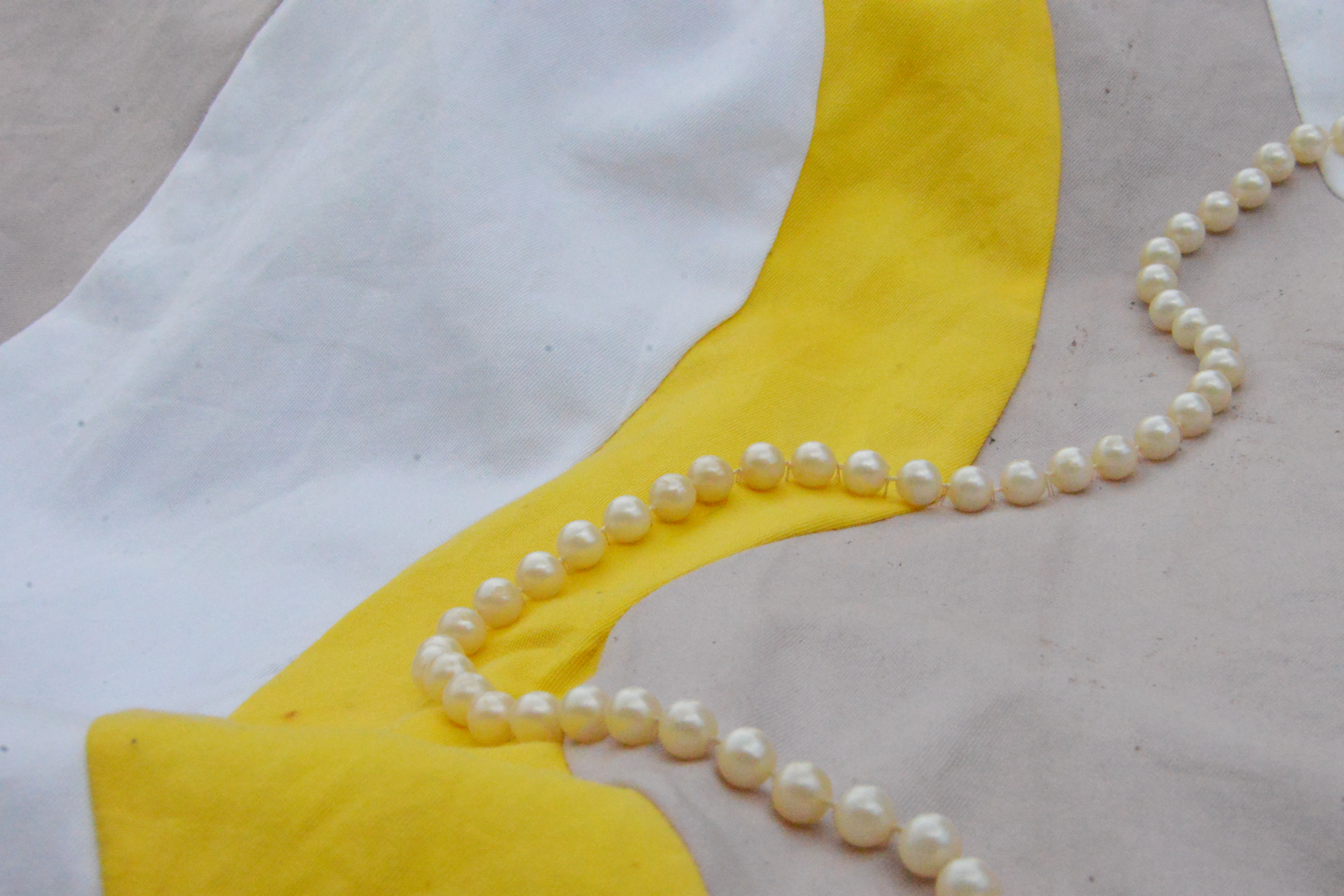
Pearls on front of the skirt
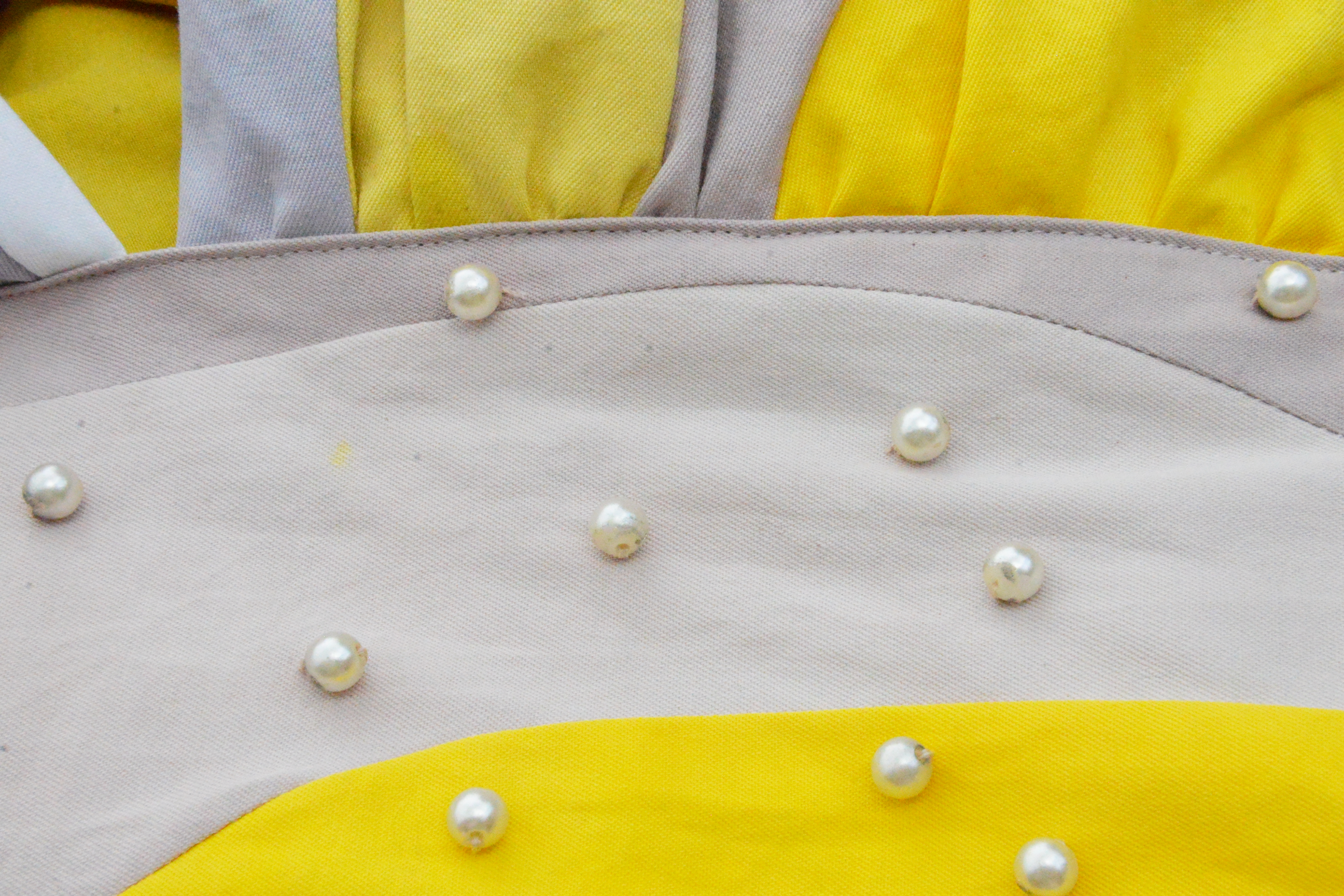
Pearls on the top

Care label
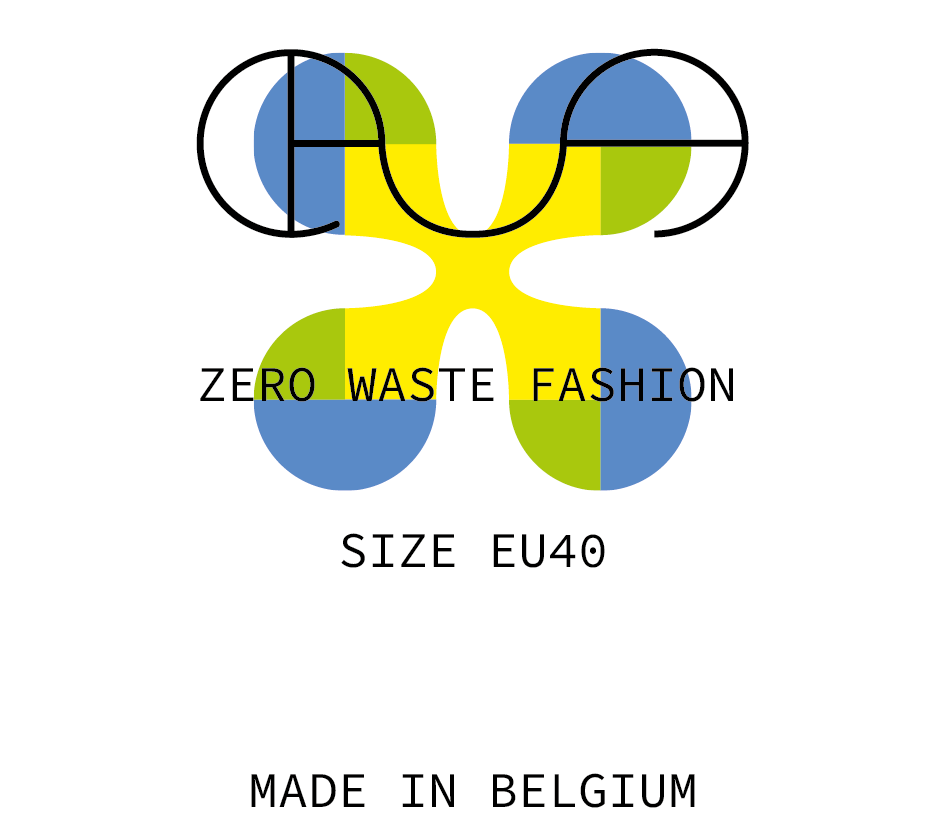
Label
LABELS
The rectangular part of the residual space is cut into 5 pieces and provided with the labels shown here, which I applied with transfer paper.
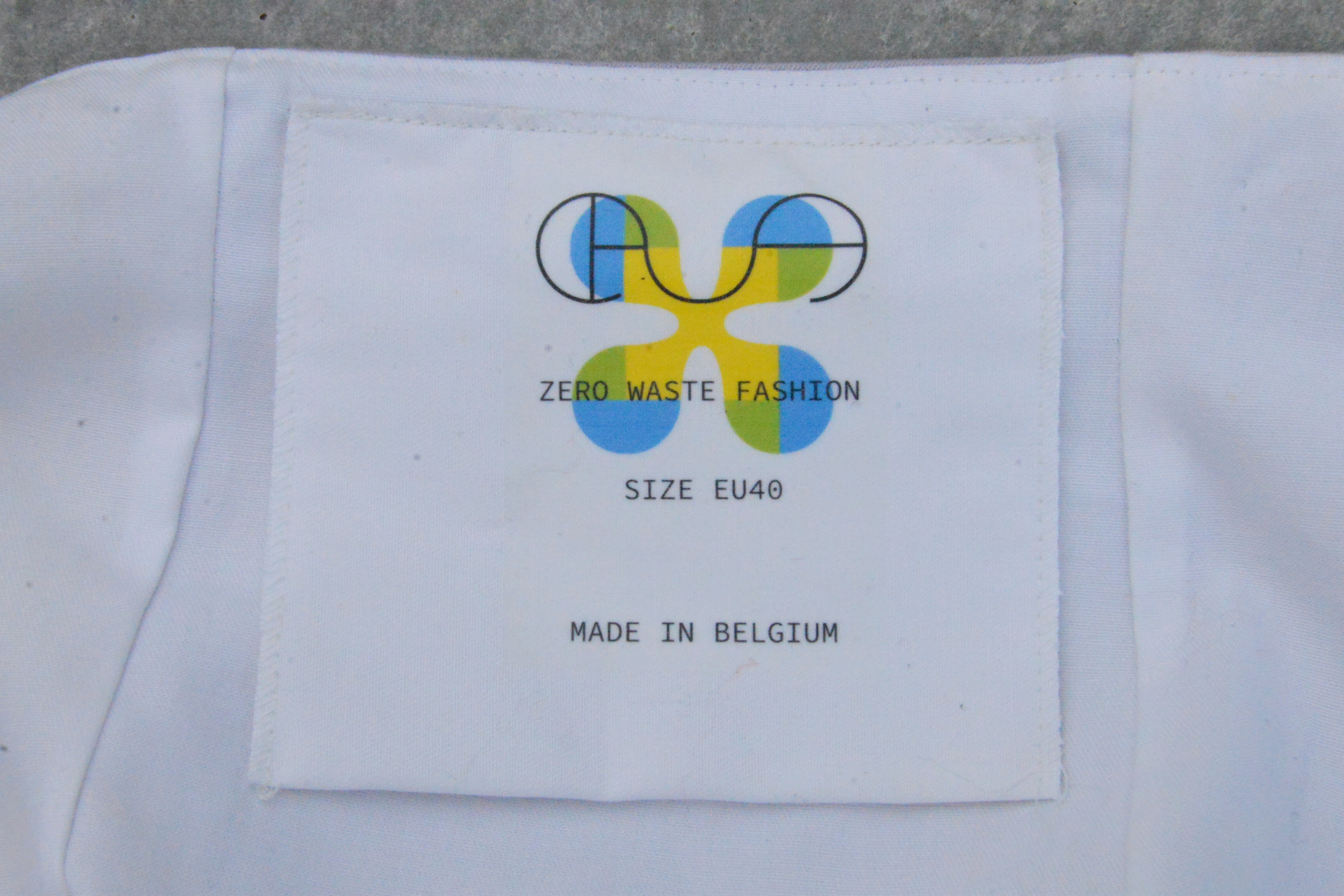
Label skirt
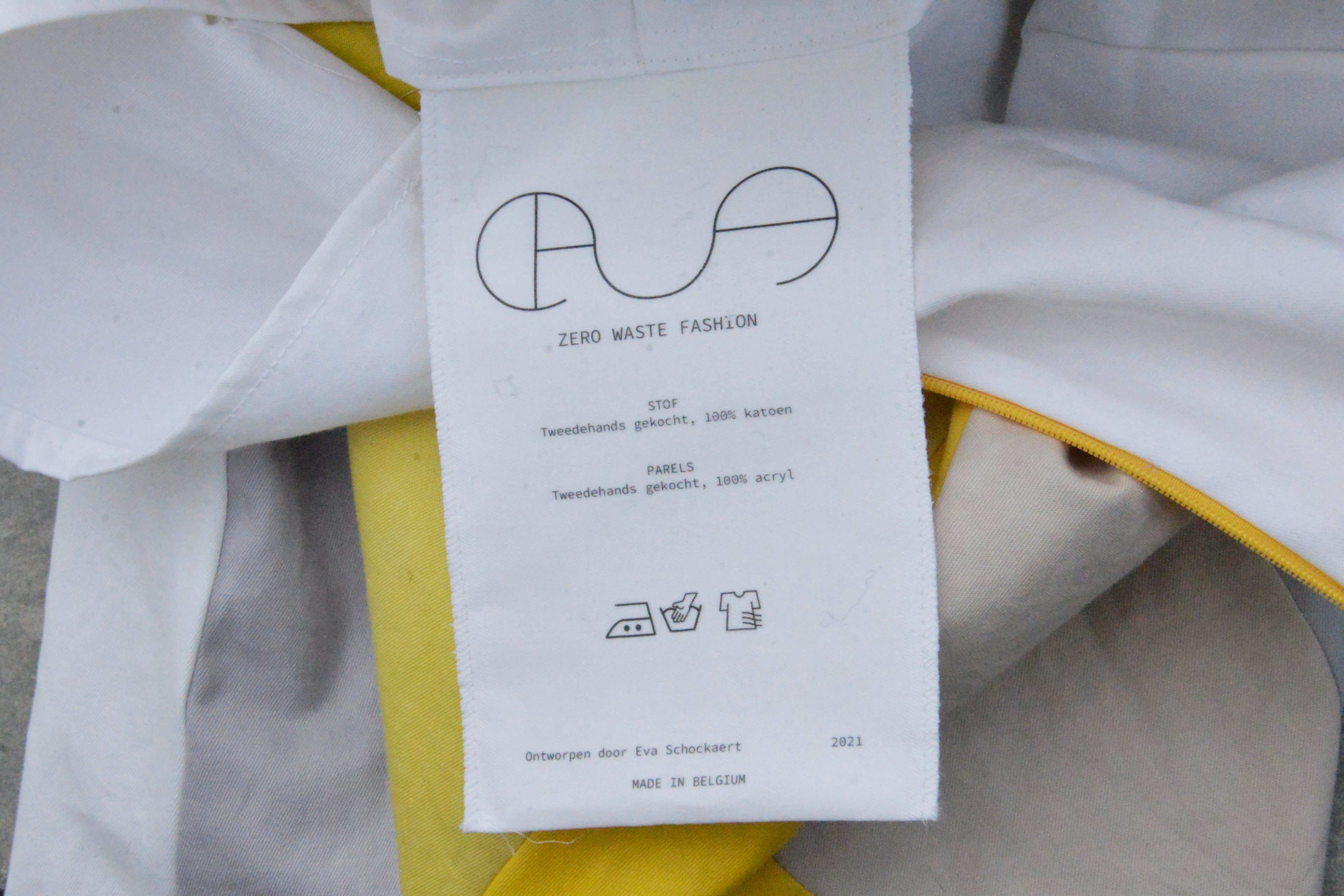
Care label skirt
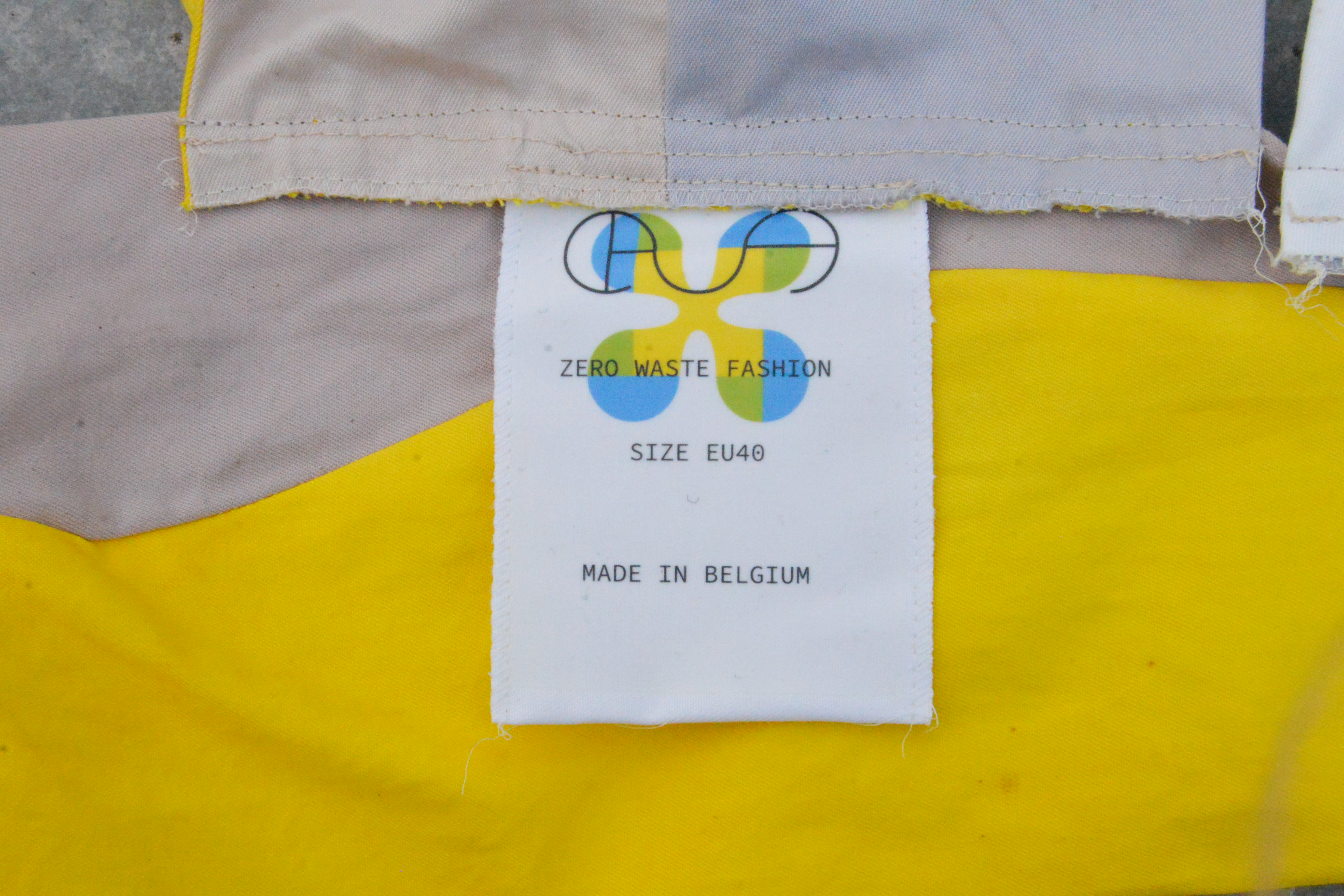
Label top

Care label top
- FINAL THOUGHTS -
The process went smoothly and was very educational. I especially learned a lot about the natural colourings while colouring my samples. Several factors must be taken into account during washing and drying. For example, I have found that the pattern pieces coloured with blueberries turn bluer when they dry in the sun, instead of the purple colour they had just after colouring. I also had to do a lot of research into a green colour. The easiest way to get green is to put a yellow and a blue together, as one would do with paint. There are not many natural products that give off a strong green colour on their own. I'm quite happy with the result of my colouring but would have liked a darker purple and a brighter pink. I am very happy with the yellow and lime green.
With all colourings, the shrinkage that is caused during cooking must be taken into account. Fortunately, each pattern piece has shrunk the same amount and only shortened in length, otherwise, I would have had a problem with the waist and hip circumference of my skirt. Due to the shrinkage, I have lost about 6 cm in the length of the skirt.
For me personally, it was not that difficult to obtain my zero-waste since I have already looked for ways to make a handbag or a top from the residual fabric in my previous designs. I was also lucky enough to find fabric in the attic that was big enough that I didn't have to buy anything new. My initial thought was to make the skirt and top in a more flexible fabric, but due to the closure of thrift shops due to the coronavirus, this fabric was my best option. Fortunately, I could have bought the two pearl necklaces before the closure.
The process obviously took a long time because of all the wavy lines on the skirt and the fabric, but this was definitely worth it because it gives my design more of the seventies look. My perfectionism has also ensured that everything took an extra long before I was satisfied with the result, but I find this characteristic an advantage with projects like this one.
Overall, I'm very happy with my result, partly because I worked on it for a long time, but also because it matches my personal style (besides the colours, I would have liked these to be brighter). It was a very instructive assignment that taught me many things that I will certainly be able to take with me to future projects.
- SOURCES -
https://bydreamsfactory.com/2020/02/how-to-make-natural-dyes-for-fabric.html/
https://www.seamwork.com/magazine/2016/05/zero-waste-design
https://www.azredbook.com/homepage-highlights-spot-4/phoenix-art-museum-showcases-minimalist-gowns-by-yeohlee/
https://www.vogue.com/fashion-shows/fall-2020-ready-to-wear/yeohlee
https://makeuse.nz/
http://www.karinvlug.com/
https://www.youtube.com/watch?v=Gk0rofqDJIk&t=1s
https://www.pinterest.com/vschckrt/_saved/
https://www.youtube.com/watch?v=HtUH9z_Oey8
Pictures used for the mood boards can be found on my Pinterest page.


